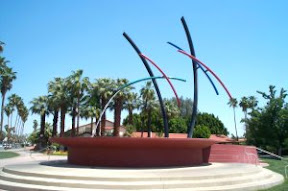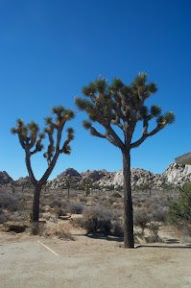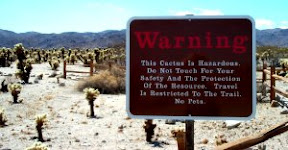Day 20 : Palm Springs
With so much hiking and travelling over the past two days, and with another five or so hours of travel ahead of us tomorrow, we decided to have a quiet day today.
We spent the morning walking the streets of downtown Palm Springs, stopping occasionally to enjoy the
 The fountain in the photo at left lies just off one of the main roads that leads into downtown Palm Springs. Debbie and I have watched it for some time, but are perplexed as to how it works. The fountain has four curved and hollow pipes that, seemingly at random, tilt forward and disgorge water from their open ends. After a quantity of water has spilled out from a particular pipe, its balance alters and its open end tilts backwards and upwards. Somehow, the pipes refill whilst in this position, only to repeat the disgorging process a short time later. It's fun to watch though.
The fountain in the photo at left lies just off one of the main roads that leads into downtown Palm Springs. Debbie and I have watched it for some time, but are perplexed as to how it works. The fountain has four curved and hollow pipes that, seemingly at random, tilt forward and disgorge water from their open ends. After a quantity of water has spilled out from a particular pipe, its balance alters and its open end tilts backwards and upwards. Somehow, the pipes refill whilst in this position, only to repeat the disgorging process a short time later. It's fun to watch though.
Only in America
As we sat in a cafe today, we could at one point hear music nearby, accompanied by what sounded like two sticks being struck on something solid in time to the music. Looking around we located the source of the noises : a man stopped at the lights in his truck, radio turned up, drumsticks in either hand, 'playing' the steering wheel.
When the light turned green he drove off, literally without missing a beat, and steering, presumably, with his knees. He did have good rhythm.
Though stupidity behind the wheel knows no national boundaries, it struck us that this was a uniquely American form of it. An Aussie would play using only one drumstick; he'd need to keep one hand free to hold the beer can.
Day 19 : Joshua Tree National Park
Today we headed out of Palm Springs, along the I-10 highway and past thousands of those energy-generating wind turbines that we showed you a photo of in the blog of a couple of days ago. After about an hour we arrived at one of the entrances to the Joshua Tree National Park having made only one wrong turn along the way. Signposting on US roads often seems designed to subtly reassure those who already have a strong idea of where they're travelling, rather than provide guidance for the first-time traveller. Many times we'll be driving along for a few miles before we realise that we did, indeed, make a correct turn at the last junction.
The Joshua Tree National Park comprises 800,000 acres, much of it wilderness. It attained Park status as a result of a 1994 act of Congress, which added about 235,000 acres to what was then the Joshua Tree National Monument. Under US law, monuments can be proclaimed by the President acting alone (the Joshua National Tree Monument was proclaimed by President Roosevelt in 1936), but National Parks can only come into being as a result of an act of Congress.
 The photo at left shows the tree after which the Park was named : the Joshua Tree. It's a giant yucca, a member of the agave family that grows like a tree. Most of the Joshua Trees we saw ranged in height from about 3 to 6 feet (about 1 to 2 metres), though there have been examples as tall as 35 feet (about 10½ metres). The species was named by Mormon travellers in the
The photo at left shows the tree after which the Park was named : the Joshua Tree. It's a giant yucca, a member of the agave family that grows like a tree. Most of the Joshua Trees we saw ranged in height from about 3 to 6 feet (about 1 to 2 metres), though there have been examples as tall as 35 feet (about 10½ metres). The species was named by Mormon travellers in the

Our first stop in the Park was at the head of a trail leading to an area called the Hidden Valley. At one time, when the vegetation was more conducive to grazing, it's thought that this area was used by a local rustler as a cattle ranch. Now, the area is full of large rocks (see photo at right) and scrubby vegetation.
Later, we stopped at an area called Keys View, which is at an elevation of 5185 feet (1581 metres). On a clear day, we're told you can see well over 100 miles (160 kilometres) from this vantage; today, like most days, was far from clear and little could be discerned more than a few miles away. What spoils the view is Los Angeles smog, carried from over 150 miles (240 kilometres) away by prevailing winds and rudely deposited in the valleys.
 On the road leading to Keys View, we came across a coyote trotting along in the same direction as us but on the left-hand side of the road (maybe it acquired its road sense in Australia). We slowed and then stopped short of the coyote, at which point it too stopped, then turned, gave the tiniest wag of its tail (we swear!) and approached the left-hand side of the car.
On the road leading to Keys View, we came across a coyote trotting along in the same direction as us but on the left-hand side of the road (maybe it acquired its road sense in Australia). We slowed and then stopped short of the coyote, at which point it too stopped, then turned, gave the tiniest wag of its tail (we swear!) and approached the left-hand side of the car.
After a time the coyote lost interest in us and just sat,
 Late in the afternoon, we stopped at the Cholla Cactus Garden. Cacti make for a strange garden. There's no pleasant scent - there's no smell at all - and, in years like this when precipitation has been low, there's little colour. Further, should you be silly enough to brush against one of the cactus plants in the garden, you need to remove the spines with a comb and some pliers. Debbie ensures that we always have a first-aid kit with us when we travel, but not even she was prepared for a cactus accident.
Late in the afternoon, we stopped at the Cholla Cactus Garden. Cacti make for a strange garden. There's no pleasant scent - there's no smell at all - and, in years like this when precipitation has been low, there's little colour. Further, should you be silly enough to brush against one of the cactus plants in the garden, you need to remove the spines with a comb and some pliers. Debbie ensures that we always have a first-aid kit with us when we travel, but not even she was prepared for a cactus accident.
We emerged, unspiked, from the cactus garden. During the trip so far we've safely negotiated the potential hazards of bears, mountain lions, rattlesnakes, giant hairy scorpions, tarantulas, coyotes and cacti. It makes air travel seem completely safe in comparison.
Originally posted by TC
No comments:
Post a Comment
Comments for posts older than 14 days will not be immediately displayed. We review these comments before publishing them for public display.